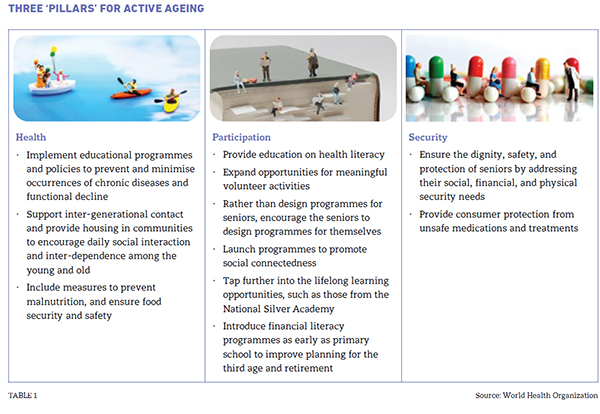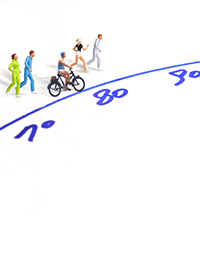Making the best of the third age.
By 2021, Singapore had one of the most rapidly ageing populations among developed nations. One in four Singaporeans would be at least 65 years old by 2030,1 and this would increase to one in two by 2050.2 Not only had life expectancy increased to 81.3 years for men and 86.1 years for women, but it was also a growing concern that about a decade of their sunset years might be spent in poor health.3,4
The Singapore government has been trying to address this issue since the 1980s when it started developing plans and policies to help seniors, defined as people who are 60 years old and above, “to not just add years to life but add life to years”.5
In 2015, the government launched the Action Plan for Successful Ageing, laying down what it would consider successful ageing in Singapore:
• Opportunities for all ages: This was to help all residents including seniors to continually learn and grow. The National Silver Academy was set up specifically to provide a wide range of learning opportunities for seniors to stay active while learning and growing at the same time. Meanwhile, the National Seniors’ Health Programme provided healthy lifestyle education and preventive health services.
• ‘Kampong’6 or a community for all ages: This was an initiative centred on inter-generational harmony. One outcome led to the provision of eldercare and childcare services within the same location in new Housing and Development Board (HDB) projects to facilitate multi-generational interactions.
• City for all ages: A revised transportation plan that focused on being senior-friendly was introduced to address the needs of seniors on the MRT (Mass Rapid Transit), buses, and roads.
The government proposed to invest S$3 billion in this comprehensive plan, comprising over 60 initiatives across 12 areas that included health and wellness, learning, and employment, to help seniors lead healthy and active lives.7
Furthermore, S$14.1 billion was set aside to address the healthcare needs of the ‘Pioneer Generation’ (people born before 1949) and the ‘Merdeka Generation’ (people born between 1950 and 1959).8 A total of 280 eldercare centres was also set up to serve this segment of people in need.9
However, despite the government’s efforts, research conducted in 2019 showed that only a quarter of the seniors demonstrated ‘successful ageing’ or were shown to be healthy enough to lead active and engaging lives.10 Ethnicity also affected the odds of successful ageing. Malay and Indian Singaporeans experienced less successful ageing compared to their Chinese counterparts. The rate of successful ageing was also lower for those who received fewer years of education.11
Given the imminent ‘silver tsunami’ with one in four Singaporeans turning 65 years or more by 2030, what else could the government do to help seniors age successfully?
SUCCESSFUL AND ACTIVE AGEING
The concept of successful ageing is based on five indicators, which include no major diseases, no disability, high cognitive function, being physically fit and mobile, and active engagement with life.12 Successful ageing coupled with positive experience in turn defines active ageing.
The World Health Organization (WHO) defines active ageing as the process of optimising opportunities in three ‘pillars’–health, participation, and security–to enhance the quality of life as people age.13 Suggestions on how to promote the rate of active ageing are listed in Table 1.

Active ageing comprises the following four elements:14
• Autonomy–the ability to make decisions and live according to one’s rules and preferences
• Independence–the ability to live independently with minimal help from others
• Quality of life–an individual’s perception of his or her position in life in the context of their culture and value systems, and in relation to their goals, expectations, standards, and concerns
• Healthy life expectancy–the ability to live without disabilities
Accompanying the discussion on successful ageing is also the rising acceptance of the ‘third age’, which is a term often used together with active ageing.15 The third age is characterised by the pursuit of voluntary, active, and rewarding activities. It is a concept that describes a period of seniors’ lives following retirement from work and cessation of responsibilities to children to pursue an active life, before a period of mental or physical decline sets in.16 The start and duration of the third age varies from individual to individual.
SENIORS IN SINGAPORE
Not all seniors in Singapore were receptive to help from external parties. Ong Siew Chin, the CEO of Blossom Seeds, a charity that focused on caring for seniors and supporting them to care for others, explained that seniors often did not accept help easily and ignored its outreach efforts.
They were also prone to suffering from social disconnection despite living with their families. Some of them did not have anyone whom they could go to for help. Others experienced a sense of being lost when they transitioned to the third age. Mike Goh, who retired at 63, said, “When I was younger, I wanted to retire early to enjoy my retirement. But when you really retire, suddenly you will find that you’re lost.”
Another issue that confronted most seniors was the prevalence of the ageism mindset in the city-state. For example, when Lien Foundation, a philanthropic organisation that aimed to improve the lives of seniors, first rolled out the ‘gym tonic’ initiative, which was a strength training programme to help seniors restore, maintain, and improve their physical mobility, it faced considerable pushback. There were ingrained perceptions in the community that strength training was ‘dangerous’ for the elderly even though it had been demonstrated otherwise in countries like Japan and Finland.
Seniors also tended to get looked at with a deficit mindset. Hence, it was not uncommon for eldercare centres to organise activities for seniors and do most things for them. With a growing population of seniors who worked full-time before their retirement, it was important to not treat them as passive recipients at eldercare centres, but rather look at ways to harness their experiences and interests by involving them more meaningfully as active contributors to the centres and the community.
Third agers in Singapore were found to have declining psychological, physical, and functional health compared to those who continued to be engaged in some form of work or the other. However, to ensure their continued engagement, seniors needed to be reskilled and upskilled as the environment was rapidly and constantly changing. The creation of the National Silver Academy was to fulfil this purpose by offering courses to seniors, so that they were constantly engaged in learning.
Another key challenge lay in the rising living and healthcare costs. Seniors living alone in Singapore needed about S$1,379 per month for their basic needs including the occasional luxury of having a meal with a friend or a short holiday abroad.19 Even though some might be property owners, they were likely to be cash-poor. Over the 2010-2018 period, Singapore’s healthcare budget had doubled from S$10 billion to S$21 billion, and it was expected to further grow to S$59 billion by 2030.
ENABLING SUCCESSFUL AGEING
All members of society, from individuals and non-profit organisations to companies and governments, need to grapple with the challenges of an ageing Singapore. One way would be to better understand the pillars that drive successful ageing. What else could be done to enable more seniors to age successfully and address the imminent silver tsunami? What are some concepts and frameworks that can guide governments, businesses, and non-profit organisations in understanding and enabling successful ageing?
|
SNAPSHOTS OF CHALLENGES FACED: STORIES OF MADAM HASLINA AND MADAM LEE Madam Haslina was an example of a senior who did not experience successful ageing before she was referred to Blossom Seeds. She was living all by herself and had no source of income. She was unable to work due to her old age and declining health. And she had no one to turn to when her only son was imprisoned for drug abuse. The team at Blossom Seeds got to know her through its befriending programme conducted in collaboration with the Council for Third Age (C3A)17. However, whenever the volunteers visited Madam Haslina, she would simply ignore them. She would not talk to any of them and declined whatever help that was offered. The breakthrough happened when late one evening, she called the programme coordinator out of the blue. She had run out of money and urgently needed to buy groceries. Even though it was inconvenient for the programme coordinator, he immediately dropped everything and rushed to the supermarket to buy the groceries that she needed, and also gave her some money to tide her over. This incident made Madam Haslina realise that the volunteers were truly committed to people like her, and she started visiting the Blossom Seeds centre. Madam Lee, who was in her 60s, was also a beneficiary of Blossom Seeds’ befriending services. She had just recovered from cancer and was very frail. She also had mobility issues and needed a walking frame or a wheelchair to move around. Her mother, and subsequently, her sister, cared for her before they passed on. Her sister had referred her to Blossom Seeds in September 2019, when it became too difficult for her to care for Madam Lee. Like Madam Haslina, Madam Lee too was initially reserved and quiet. She did not want to talk to anyone and was not used to having company. She seldom stepped out of her home, had no friends, and had never worked in her life. It took a while for the team of volunteers from Blossom Seeds to get to know her. They spent time helping her find meaning in life and renew her interest in it. They encouraged her to attend the activities and festivities at the centre. After considerable effort, she eventually agreed to attend the Winter Solstice Festival18 celebration, and thereafter began to regularly attend the weekly activities at the centre. |
Dr Ma Kheng Min
is Senior Lecturer of Organisational Behaviour and Human Resources, and Director of Undergraduate Admissions at Lee Kong Chian School of Business, Singapore Management University
Dr Jovina Ang
is Senior Adjunct Fellow at the Singapore University of Technology and Design
Dr Sheetal Bhardwaj
is Senior Case Writer at the Centre for Management Practice at Singapore Management University
This article is based on the case study ‘Driving Successful Ageing in Singapore’ published by the Centre for Management Practice at Singapore Management University. For more information, please visit https://cmp.smu.edu.sg/case/5096 or scan the QR code below

Endnotes
1. Jolene Ang, “Singapore’s Approach to Healthy Ageing is to See It as a Positive Force”, The Straits Times, March 23, 2021.
2. Siau Ming En, “Elderly to Make Up Almost Half of S’pore Population by 2050: United Nations”, TODAY, August 13, 2019.
3. Ibid.
4. Elaine L. E. Ho and Shirlena Huang, “Care Where You Are: Enabling Singaporeans to Age Well in the Community”, Lien Foundation, August 2018.
5. Jolene Ang, “Singapore’s Approach to Healthy Ageing is to See It as a Positive Force”, The Straits Times, March 23, 2021.
6. ‘Kampong’ is the Malay word for ‘village’.
7. Ministry of Health, “The Action Plan for Successful Ageing”, 2016.
8. Ibid.
9. Fabian Koh, “Seniors to Receive Help at 280 Eldercare Centres Regardless of Income and Health: MOH”, The Straits Times, December 7, 2020.
10. Mythily Subramaniam, Edimansyah Abdin, Janhavi A. Vaingankar, et al., “Successful Ageing in Singapore: Prevalence and Correlates from a National Survey of Older Adults”, Singapore Medical Journal, 60(1), 22-30, 2019.
11. Ibid.
12. Ibid.
13. World Health Organization (WHO), “Active Ageing: A Policy Framework”, Second United Nations World Assembly on Ageing, Madrid, Spain, April 2002.
14. Ibid.
15. The term ‘third age’ was coined by the late Peter Laslett, a British historian who specialised in demography and societal change.
16. Peter Laslett, “A Fresh Map of Life: The Emergence of the Third Age”, Boston: Harvard Business Review Press, 1991.
17. The C3A is an agency that was set up by the Singapore government in May 2007 to promote active ageing through lifelong learning, senior volunteerism, and positive ageing.
18. The Winter Solstice Festival is an important Chinese festival that celebrates family reunion. It typically falls between December 21 and 23 each year.
19. Janice Lim, “Singapore Seniors Each Need at Least S$1,379 Monthly to Meet Basic Needs: Study”, Today, May 23, 2019.
